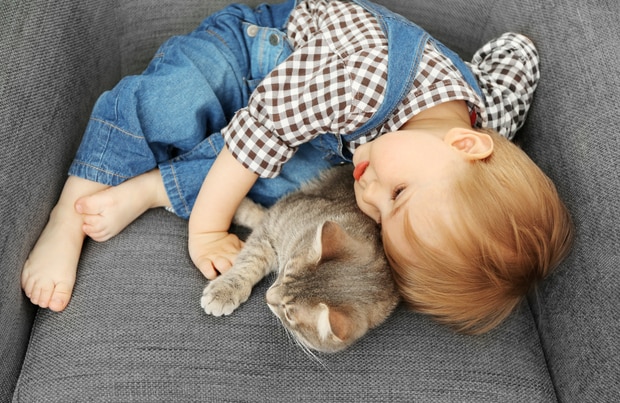Between the excitement, lots of noise and new people, it’s no wonder that dogs often find family gatherings unsettling. With an anxious dog, there’s a higher chance that he can display aggressive behaviors. This is especially true when an unfamiliar child is involved, as the dog has no history with that child to offset whatever odd thing is going on, explains Irith Bloom, a certified dog trainer, certified dog behavior consultant, and Director of Training at The Sophisticated Dog. “Leaving children and dogs together unsupervised is always a bad idea, and when they don’t know each other at all, it’s an even worse idea,” says Bloom.
If kids and pets are going to be part of your holiday plans, here are some precautions you can take to ensure the safety of both dogs and children, and make sure everybody has a good time.
5 Tips to Ensure Safety for Kids and Pets
-
Take Your Time to Introduce Them
Perhaps one of the biggest mistakes you can make regarding kids and pets safety is to assume that kids will know how to interact with a dog—especially a dog that is already overstimulated by the influx of activity and strangers during holiday celebrations. In fact, even the best pets for kids need to learn how to appropriately interact with children.
If the kids are not familiar with doggy etiquette, have a chat with them and explain the proper ways to interact with a dog. There are two essential rules that kids should be taught. The first is when greeting the dog, they should wait for the dog to come up to them. They should not rush up to the dog and should never put their face directly in the dog’s face. It is best for them to hold their hands out and allow the dog to sniff them as a greeting. The second is to teach them how to properly pet a dog. Bloom recommends showing kids where your dog likes to be pet (some dogs might prefer the flanks, while others like their ears scratched). They should also be taught that dogs do not enjoy hugs.
-
Don’t Ignore Signs of Doggy Stress
Dogs tend to be most relaxed when things follow a predictable pattern or routine—so when holiday celebrations disrupt the normal routine, it’s no surprise that dogs can be a little on edge and more likely to become reactive. “A dog who normally gets along with visitors might not react as well to the next visitor when there is music in the background and 20 people have arrived at the house already,” says Bloom. “This is especially true where children are concerned, as children often do sudden, surprising, or even painful things to dogs.”
To avoid trouble and ensure kids and pets safety, always keep an eye on the body language of your dog. “If the dog is enjoying being with the child, he will tend to look loose and wiggly,” says Bloom. “His muscles will be relaxed, his mouth may be open in a gentle pant, and he will be watching the child with soft eyes.”
A stressed dog, on the other hand, may be stiff or have his mouth closed, according to Bloom. Especially if there’s more than one child running around, you should be prepared to give your dog a way out to ensure safety for kids. “As soon as you see these types of signals, it’s time to give the dog a break by giving the child something else to do—away from the dog,” says Bloom.
-
Keep an Eye on the Action
While well-trained dogs usually have a little more self-control than young puppies or untrained dogs, child safety is never guaranteed around dogs, especially strange dogs, according to Bloom. “Even a well-trained dog may react if he is being poked, pulled at, or prodded to the point of severe pain,” says Bloom.
To make sure both kids and pets remain safe and happy during holiday celebrations, Bloom recommends that all interactions be supervised. “Whenever children and dogs are together, an adult should be in the area carefully monitoring everyone’s behavior, and the child and dog should be given a break from each other any time either of them start to show signs of stress.” Give your dog interactive toys like the Ethical Pet Seek-A-Treat Shuffle Bone Puzzle Dog Toy when he needs some alone time somewhere else, so he doesn’t feel like he’s being punished.
-
Encourage Safe Games
Safety for kids and pets should be an essential part of choosing games that children and pets can play together. “A generally good game for dogs and children is fetch, since fetch does not require the child and the dog to hold a toy at the same time,” says Bloom. “Fetch also gives the dog an appropriate thing to do with his teeth (hold the toy), which means he’s less likely to put his teeth on the child.” You can even use the Chuckit! Classic Launcher to keep hands dry and clean during a game of Fetch. For cat toys that won’t result in scratches, kids can use the Petlinks Fun Beam Laser Cat Toy.
Bloom points out that games like tug can result in accidental bites if the child and dog both try to grab the same part of the toy. Child and animal safety might also be compromised during games of chase. “It’s easy for a child to get knocked down or for an overexcited dog to wind up putting teeth on the child,” says Bloom.
-
Protect Your Dog
If you have a small or fragile dog, it’s not just the kids you have to worry about—you also need to keep your eyes open for dog safety. “Children are not as gentle as adults, and part of this is lack of motor control—young children simply don’t have the same level of finesse in how they move their bodies,” says Bloom. “Another part of this is lack of empathy—the understanding that something that hurts one’s self can also cause an animal pain.”
In addition, Bloom points out that because of their size and cute appearance, small dogs can also seem a lot like stuffed toys to children. “Unfortunately, unlike stuffed toys, small dogs can get bruised or even have their bones broken when handled roughly,” says Bloom. “Even larger dogs have sensitive parts of their bodies—their tails, which are relatively easy to damage, and their ears and eyes, where it doesn’t take a lot of force to cause a lot of pain, or even permanent damage.”
The lesson? When it comes to children and dogs, don’t be afraid to be overly careful. That means not only telling and teaching children how to treat dogs, but also supervising all interactions. This is especially important with a child who’s not used to being around dogs and doesn’t quite understand how to appropriately interact with them.

Diana Bocco is a full-time writer and adventurer who has written for National Geographic, DiscoveryChannel.com, Yahoo! and Marie Claire. Diana has lived in five countries and taken her rescued dogs along to each one of them.
Share:












